Sustainability Audit of Motorcycle Components: Mechanical Engineering
VerifiedAdded on 2020/05/28
|50
|9695
|62
Report
AI Summary
This mechanical engineering report provides a comprehensive sustainability analysis of motorcycles, exploring various aspects from material sourcing and product exploration to design for function and environmental impact assessment. The report delves into the specifics of motorcycle components such as engines, wheels, and batteries, analyzing their construction, material choices, and potential sustainability improvements. Utilizing the Granta CES Edupack software, the study conducts an eco-audit, evaluates energy emissions, and performs cost analysis to provide a holistic view of the motorcycle's lifecycle. It also identifies current good and bad practices within the industry and offers recommendations for enhancing sustainability. The report includes detailed discussions on component choices, manufacturing processes, and problem definitions, alongside graphical representations and software analysis results to support the findings and conclusions regarding overall motorcycle sustainability.
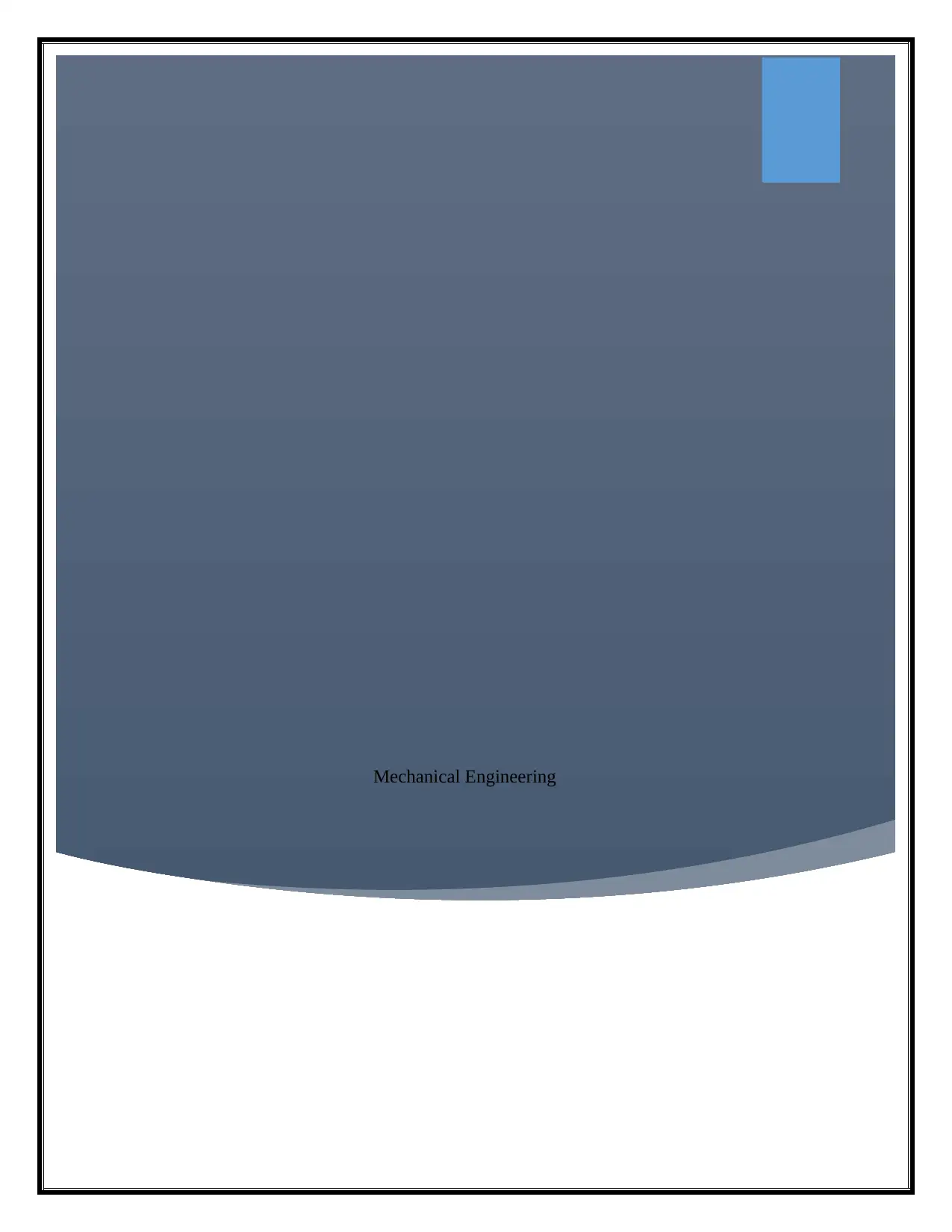
Mechanical Engineering
Paraphrase This Document
Need a fresh take? Get an instant paraphrase of this document with our AI Paraphraser
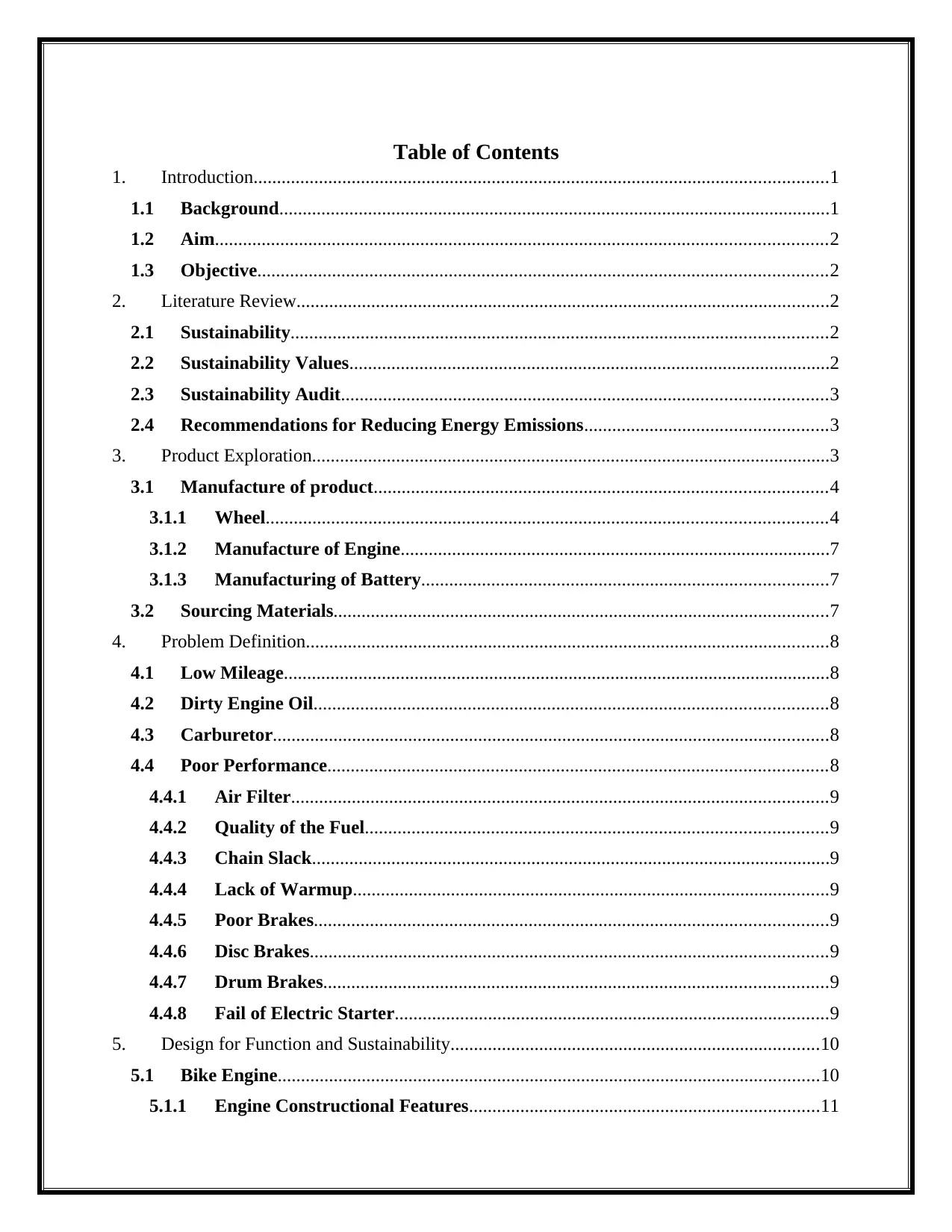
Table of Contents
1. Introduction...........................................................................................................................1
1.1 Background......................................................................................................................1
1.2 Aim...................................................................................................................................2
1.3 Objective..........................................................................................................................2
2. Literature Review..................................................................................................................2
2.1 Sustainability...................................................................................................................2
2.2 Sustainability Values.......................................................................................................2
2.3 Sustainability Audit........................................................................................................3
2.4 Recommendations for Reducing Energy Emissions....................................................3
3. Product Exploration...............................................................................................................3
3.1 Manufacture of product.................................................................................................4
3.1.1 Wheel........................................................................................................................4
3.1.2 Manufacture of Engine............................................................................................7
3.1.3 Manufacturing of Battery.......................................................................................7
3.2 Sourcing Materials..........................................................................................................7
4. Problem Definition................................................................................................................8
4.1 Low Mileage.....................................................................................................................8
4.2 Dirty Engine Oil..............................................................................................................8
4.3 Carburetor.......................................................................................................................8
4.4 Poor Performance...........................................................................................................8
4.4.1 Air Filter...................................................................................................................9
4.4.2 Quality of the Fuel...................................................................................................9
4.4.3 Chain Slack...............................................................................................................9
4.4.4 Lack of Warmup......................................................................................................9
4.4.5 Poor Brakes..............................................................................................................9
4.4.6 Disc Brakes...............................................................................................................9
4.4.7 Drum Brakes............................................................................................................9
4.4.8 Fail of Electric Starter.............................................................................................9
5. Design for Function and Sustainability...............................................................................10
5.1 Bike Engine....................................................................................................................10
5.1.1 Engine Constructional Features...........................................................................11
1. Introduction...........................................................................................................................1
1.1 Background......................................................................................................................1
1.2 Aim...................................................................................................................................2
1.3 Objective..........................................................................................................................2
2. Literature Review..................................................................................................................2
2.1 Sustainability...................................................................................................................2
2.2 Sustainability Values.......................................................................................................2
2.3 Sustainability Audit........................................................................................................3
2.4 Recommendations for Reducing Energy Emissions....................................................3
3. Product Exploration...............................................................................................................3
3.1 Manufacture of product.................................................................................................4
3.1.1 Wheel........................................................................................................................4
3.1.2 Manufacture of Engine............................................................................................7
3.1.3 Manufacturing of Battery.......................................................................................7
3.2 Sourcing Materials..........................................................................................................7
4. Problem Definition................................................................................................................8
4.1 Low Mileage.....................................................................................................................8
4.2 Dirty Engine Oil..............................................................................................................8
4.3 Carburetor.......................................................................................................................8
4.4 Poor Performance...........................................................................................................8
4.4.1 Air Filter...................................................................................................................9
4.4.2 Quality of the Fuel...................................................................................................9
4.4.3 Chain Slack...............................................................................................................9
4.4.4 Lack of Warmup......................................................................................................9
4.4.5 Poor Brakes..............................................................................................................9
4.4.6 Disc Brakes...............................................................................................................9
4.4.7 Drum Brakes............................................................................................................9
4.4.8 Fail of Electric Starter.............................................................................................9
5. Design for Function and Sustainability...............................................................................10
5.1 Bike Engine....................................................................................................................10
5.1.1 Engine Constructional Features...........................................................................11
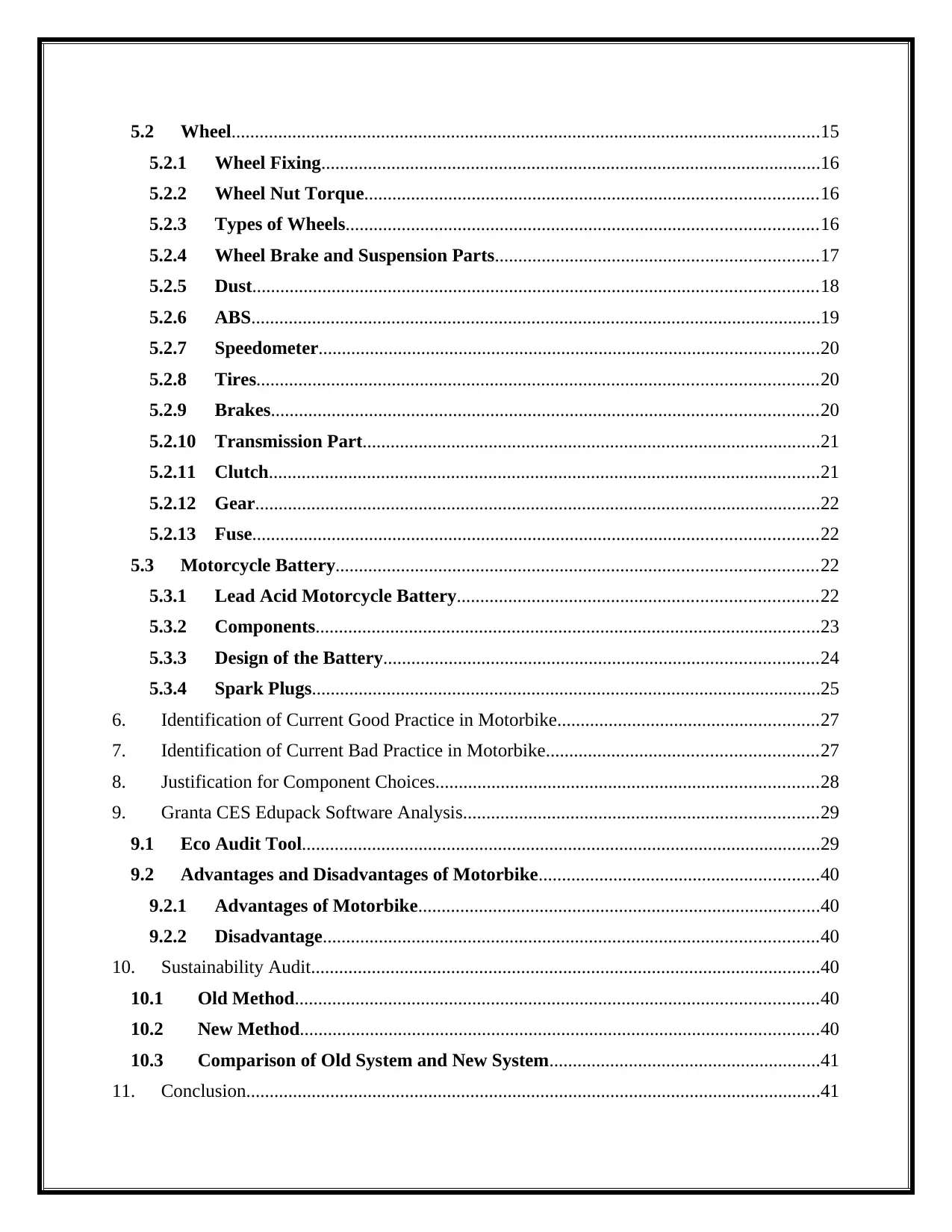
5.2 Wheel..............................................................................................................................15
5.2.1 Wheel Fixing...........................................................................................................16
5.2.2 Wheel Nut Torque.................................................................................................16
5.2.3 Types of Wheels.....................................................................................................16
5.2.4 Wheel Brake and Suspension Parts.....................................................................17
5.2.5 Dust.........................................................................................................................18
5.2.6 ABS..........................................................................................................................19
5.2.7 Speedometer...........................................................................................................20
5.2.8 Tires........................................................................................................................20
5.2.9 Brakes.....................................................................................................................20
5.2.10 Transmission Part..................................................................................................21
5.2.11 Clutch......................................................................................................................21
5.2.12 Gear.........................................................................................................................22
5.2.13 Fuse.........................................................................................................................22
5.3 Motorcycle Battery.......................................................................................................22
5.3.1 Lead Acid Motorcycle Battery.............................................................................22
5.3.2 Components............................................................................................................23
5.3.3 Design of the Battery.............................................................................................24
5.3.4 Spark Plugs.............................................................................................................25
6. Identification of Current Good Practice in Motorbike........................................................27
7. Identification of Current Bad Practice in Motorbike..........................................................27
8. Justification for Component Choices..................................................................................28
9. Granta CES Edupack Software Analysis............................................................................29
9.1 Eco Audit Tool...............................................................................................................29
9.2 Advantages and Disadvantages of Motorbike............................................................40
9.2.1 Advantages of Motorbike......................................................................................40
9.2.2 Disadvantage..........................................................................................................40
10. Sustainability Audit.............................................................................................................40
10.1 Old Method................................................................................................................40
10.2 New Method...............................................................................................................40
10.3 Comparison of Old System and New System..........................................................41
11. Conclusion...........................................................................................................................41
5.2.1 Wheel Fixing...........................................................................................................16
5.2.2 Wheel Nut Torque.................................................................................................16
5.2.3 Types of Wheels.....................................................................................................16
5.2.4 Wheel Brake and Suspension Parts.....................................................................17
5.2.5 Dust.........................................................................................................................18
5.2.6 ABS..........................................................................................................................19
5.2.7 Speedometer...........................................................................................................20
5.2.8 Tires........................................................................................................................20
5.2.9 Brakes.....................................................................................................................20
5.2.10 Transmission Part..................................................................................................21
5.2.11 Clutch......................................................................................................................21
5.2.12 Gear.........................................................................................................................22
5.2.13 Fuse.........................................................................................................................22
5.3 Motorcycle Battery.......................................................................................................22
5.3.1 Lead Acid Motorcycle Battery.............................................................................22
5.3.2 Components............................................................................................................23
5.3.3 Design of the Battery.............................................................................................24
5.3.4 Spark Plugs.............................................................................................................25
6. Identification of Current Good Practice in Motorbike........................................................27
7. Identification of Current Bad Practice in Motorbike..........................................................27
8. Justification for Component Choices..................................................................................28
9. Granta CES Edupack Software Analysis............................................................................29
9.1 Eco Audit Tool...............................................................................................................29
9.2 Advantages and Disadvantages of Motorbike............................................................40
9.2.1 Advantages of Motorbike......................................................................................40
9.2.2 Disadvantage..........................................................................................................40
10. Sustainability Audit.............................................................................................................40
10.1 Old Method................................................................................................................40
10.2 New Method...............................................................................................................40
10.3 Comparison of Old System and New System..........................................................41
11. Conclusion...........................................................................................................................41
⊘ This is a preview!⊘
Do you want full access?
Subscribe today to unlock all pages.

Trusted by 1+ million students worldwide
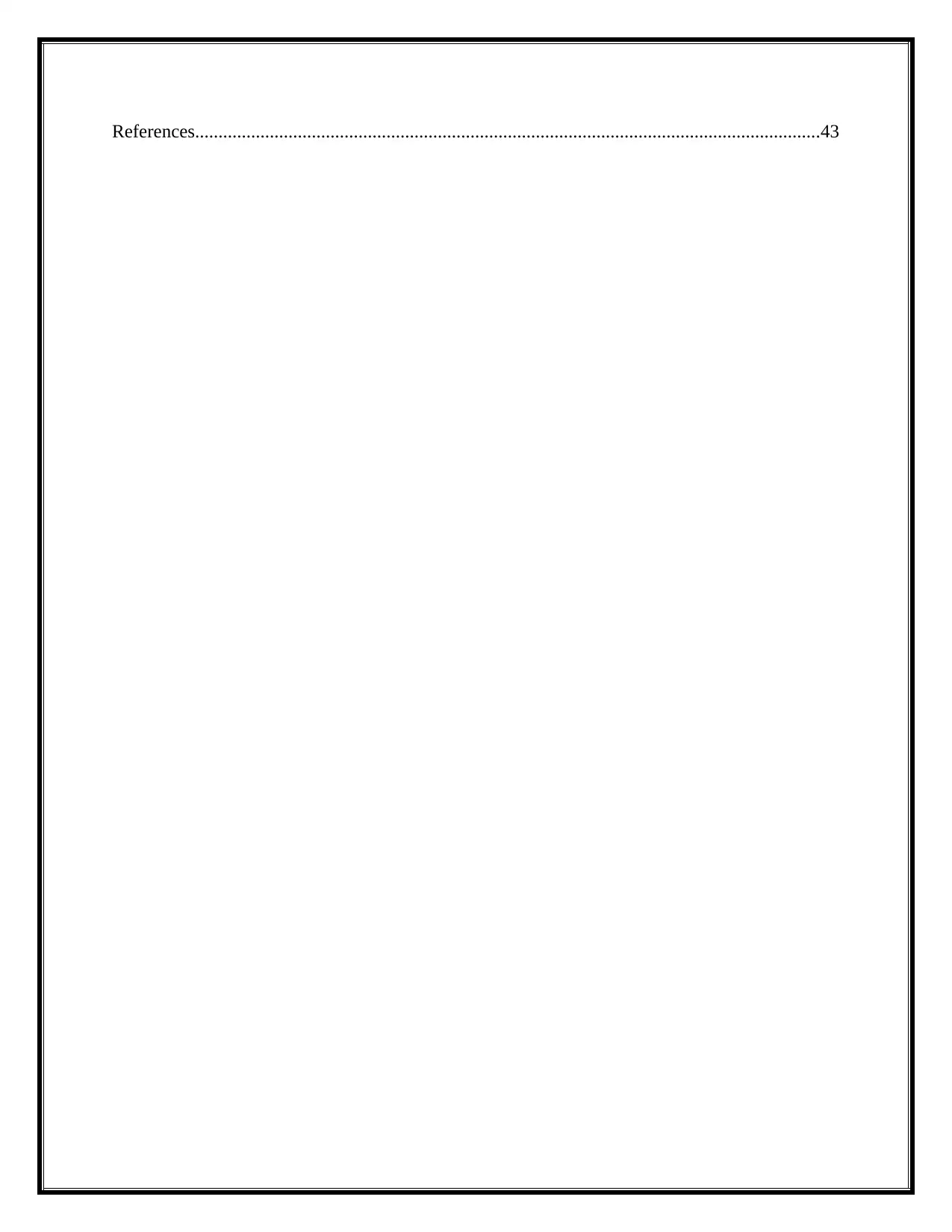
References......................................................................................................................................43
Paraphrase This Document
Need a fresh take? Get an instant paraphrase of this document with our AI Paraphraser
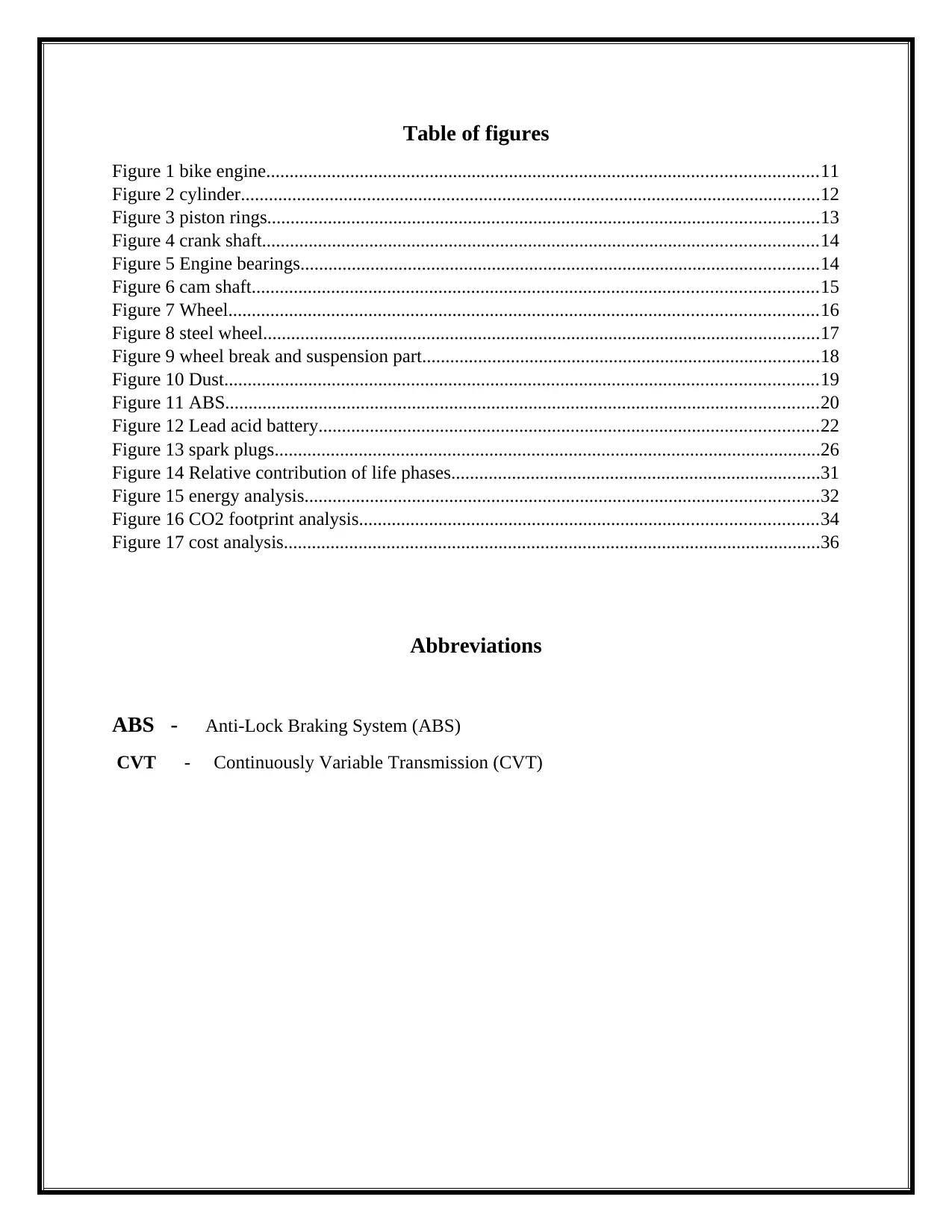
Table of figures
Figure 1 bike engine......................................................................................................................11
Figure 2 cylinder............................................................................................................................12
Figure 3 piston rings......................................................................................................................13
Figure 4 crank shaft.......................................................................................................................14
Figure 5 Engine bearings...............................................................................................................14
Figure 6 cam shaft.........................................................................................................................15
Figure 7 Wheel..............................................................................................................................16
Figure 8 steel wheel.......................................................................................................................17
Figure 9 wheel break and suspension part.....................................................................................18
Figure 10 Dust...............................................................................................................................19
Figure 11 ABS...............................................................................................................................20
Figure 12 Lead acid battery...........................................................................................................22
Figure 13 spark plugs.....................................................................................................................26
Figure 14 Relative contribution of life phases...............................................................................31
Figure 15 energy analysis..............................................................................................................32
Figure 16 CO2 footprint analysis..................................................................................................34
Figure 17 cost analysis...................................................................................................................36
Abbreviations
ABS - Anti-Lock Braking System (ABS)
CVT - Continuously Variable Transmission (CVT)
Figure 1 bike engine......................................................................................................................11
Figure 2 cylinder............................................................................................................................12
Figure 3 piston rings......................................................................................................................13
Figure 4 crank shaft.......................................................................................................................14
Figure 5 Engine bearings...............................................................................................................14
Figure 6 cam shaft.........................................................................................................................15
Figure 7 Wheel..............................................................................................................................16
Figure 8 steel wheel.......................................................................................................................17
Figure 9 wheel break and suspension part.....................................................................................18
Figure 10 Dust...............................................................................................................................19
Figure 11 ABS...............................................................................................................................20
Figure 12 Lead acid battery...........................................................................................................22
Figure 13 spark plugs.....................................................................................................................26
Figure 14 Relative contribution of life phases...............................................................................31
Figure 15 energy analysis..............................................................................................................32
Figure 16 CO2 footprint analysis..................................................................................................34
Figure 17 cost analysis...................................................................................................................36
Abbreviations
ABS - Anti-Lock Braking System (ABS)
CVT - Continuously Variable Transmission (CVT)
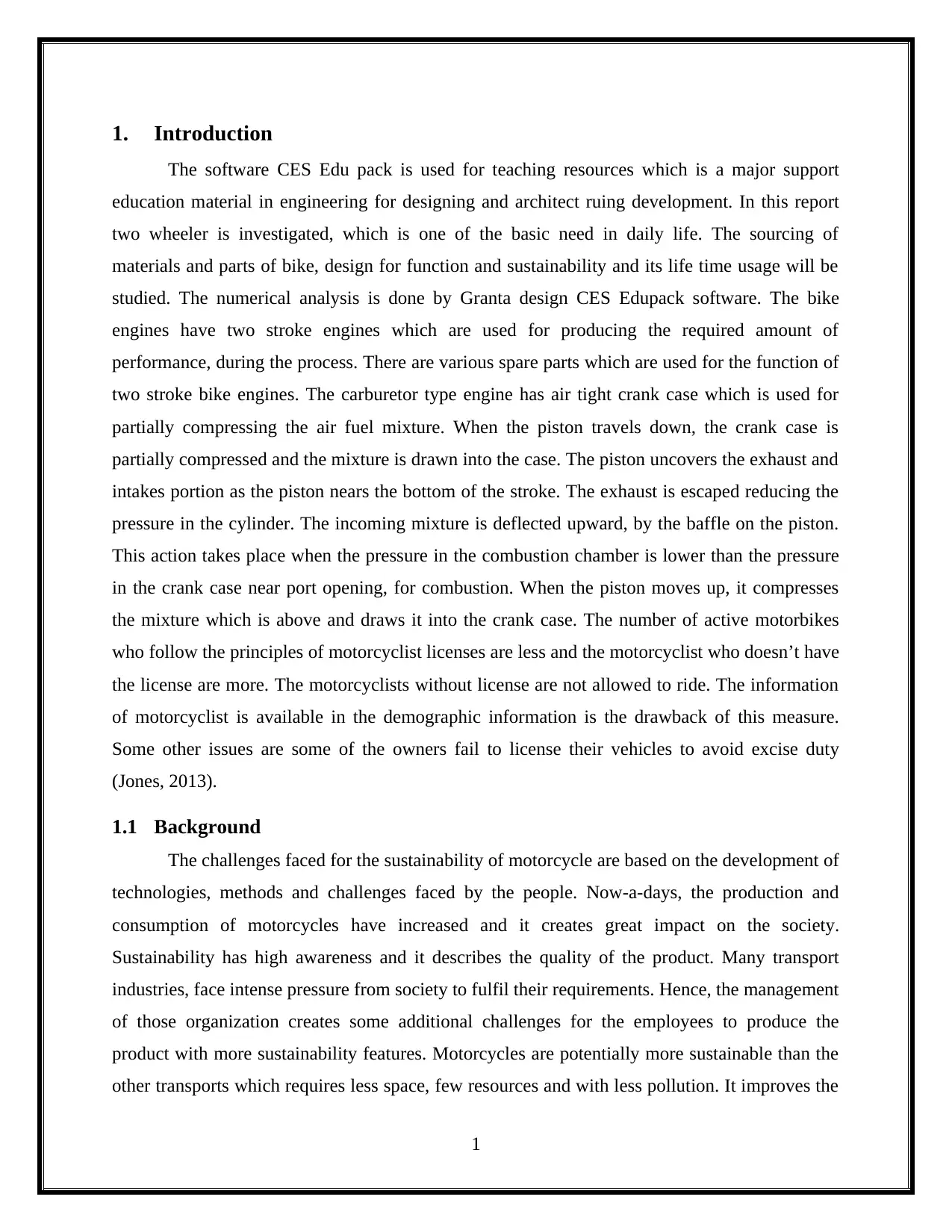
1. Introduction
The software CES Edu pack is used for teaching resources which is a major support
education material in engineering for designing and architect ruing development. In this report
two wheeler is investigated, which is one of the basic need in daily life. The sourcing of
materials and parts of bike, design for function and sustainability and its life time usage will be
studied. The numerical analysis is done by Granta design CES Edupack software. The bike
engines have two stroke engines which are used for producing the required amount of
performance, during the process. There are various spare parts which are used for the function of
two stroke bike engines. The carburetor type engine has air tight crank case which is used for
partially compressing the air fuel mixture. When the piston travels down, the crank case is
partially compressed and the mixture is drawn into the case. The piston uncovers the exhaust and
intakes portion as the piston nears the bottom of the stroke. The exhaust is escaped reducing the
pressure in the cylinder. The incoming mixture is deflected upward, by the baffle on the piston.
This action takes place when the pressure in the combustion chamber is lower than the pressure
in the crank case near port opening, for combustion. When the piston moves up, it compresses
the mixture which is above and draws it into the crank case. The number of active motorbikes
who follow the principles of motorcyclist licenses are less and the motorcyclist who doesn’t have
the license are more. The motorcyclists without license are not allowed to ride. The information
of motorcyclist is available in the demographic information is the drawback of this measure.
Some other issues are some of the owners fail to license their vehicles to avoid excise duty
(Jones, 2013).
1.1 Background
The challenges faced for the sustainability of motorcycle are based on the development of
technologies, methods and challenges faced by the people. Now-a-days, the production and
consumption of motorcycles have increased and it creates great impact on the society.
Sustainability has high awareness and it describes the quality of the product. Many transport
industries, face intense pressure from society to fulfil their requirements. Hence, the management
of those organization creates some additional challenges for the employees to produce the
product with more sustainability features. Motorcycles are potentially more sustainable than the
other transports which requires less space, few resources and with less pollution. It improves the
1
The software CES Edu pack is used for teaching resources which is a major support
education material in engineering for designing and architect ruing development. In this report
two wheeler is investigated, which is one of the basic need in daily life. The sourcing of
materials and parts of bike, design for function and sustainability and its life time usage will be
studied. The numerical analysis is done by Granta design CES Edupack software. The bike
engines have two stroke engines which are used for producing the required amount of
performance, during the process. There are various spare parts which are used for the function of
two stroke bike engines. The carburetor type engine has air tight crank case which is used for
partially compressing the air fuel mixture. When the piston travels down, the crank case is
partially compressed and the mixture is drawn into the case. The piston uncovers the exhaust and
intakes portion as the piston nears the bottom of the stroke. The exhaust is escaped reducing the
pressure in the cylinder. The incoming mixture is deflected upward, by the baffle on the piston.
This action takes place when the pressure in the combustion chamber is lower than the pressure
in the crank case near port opening, for combustion. When the piston moves up, it compresses
the mixture which is above and draws it into the crank case. The number of active motorbikes
who follow the principles of motorcyclist licenses are less and the motorcyclist who doesn’t have
the license are more. The motorcyclists without license are not allowed to ride. The information
of motorcyclist is available in the demographic information is the drawback of this measure.
Some other issues are some of the owners fail to license their vehicles to avoid excise duty
(Jones, 2013).
1.1 Background
The challenges faced for the sustainability of motorcycle are based on the development of
technologies, methods and challenges faced by the people. Now-a-days, the production and
consumption of motorcycles have increased and it creates great impact on the society.
Sustainability has high awareness and it describes the quality of the product. Many transport
industries, face intense pressure from society to fulfil their requirements. Hence, the management
of those organization creates some additional challenges for the employees to produce the
product with more sustainability features. Motorcycles are potentially more sustainable than the
other transports which requires less space, few resources and with less pollution. It improves the
1
⊘ This is a preview!⊘
Do you want full access?
Subscribe today to unlock all pages.

Trusted by 1+ million students worldwide
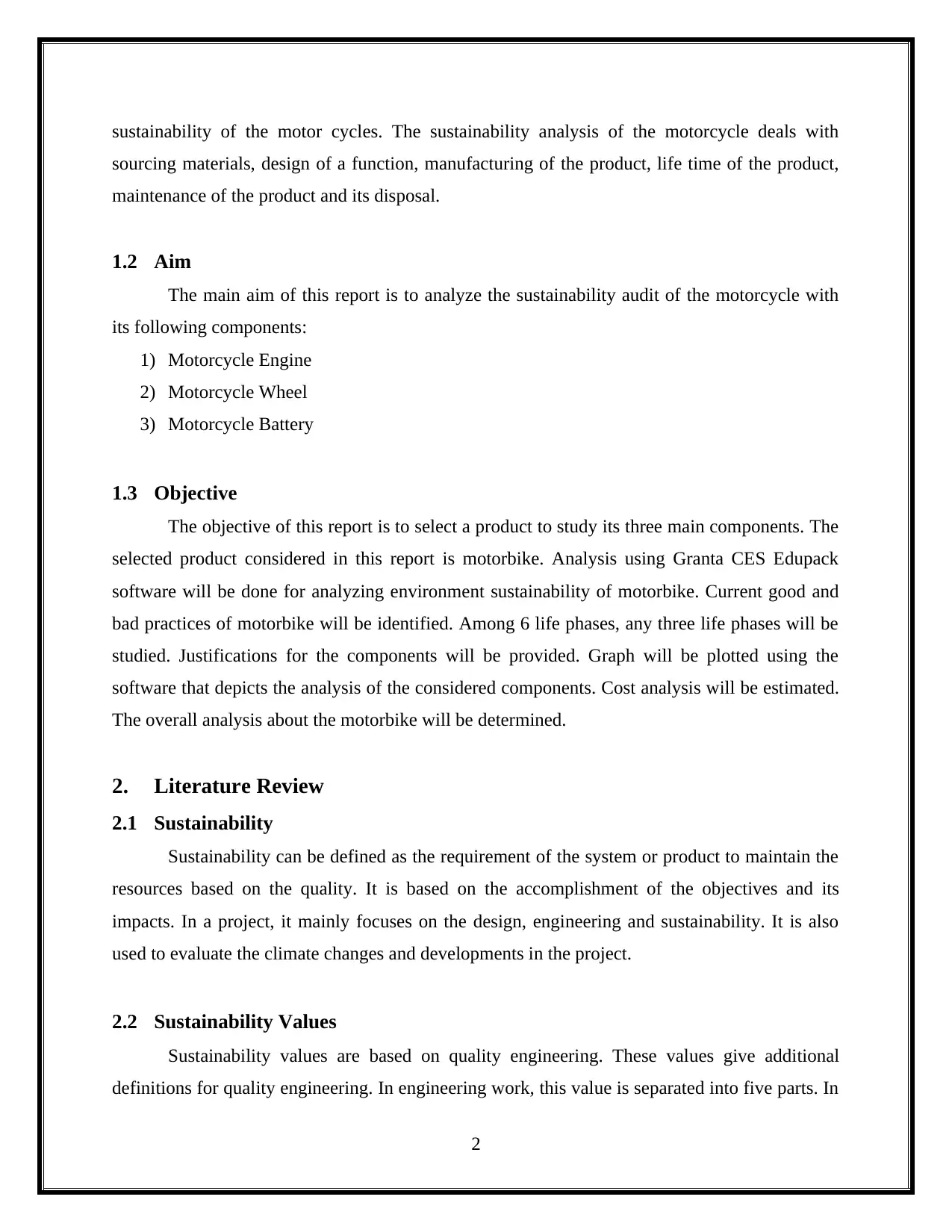
sustainability of the motor cycles. The sustainability analysis of the motorcycle deals with
sourcing materials, design of a function, manufacturing of the product, life time of the product,
maintenance of the product and its disposal.
1.2 Aim
The main aim of this report is to analyze the sustainability audit of the motorcycle with
its following components:
1) Motorcycle Engine
2) Motorcycle Wheel
3) Motorcycle Battery
1.3 Objective
The objective of this report is to select a product to study its three main components. The
selected product considered in this report is motorbike. Analysis using Granta CES Edupack
software will be done for analyzing environment sustainability of motorbike. Current good and
bad practices of motorbike will be identified. Among 6 life phases, any three life phases will be
studied. Justifications for the components will be provided. Graph will be plotted using the
software that depicts the analysis of the considered components. Cost analysis will be estimated.
The overall analysis about the motorbike will be determined.
2. Literature Review
2.1 Sustainability
Sustainability can be defined as the requirement of the system or product to maintain the
resources based on the quality. It is based on the accomplishment of the objectives and its
impacts. In a project, it mainly focuses on the design, engineering and sustainability. It is also
used to evaluate the climate changes and developments in the project.
2.2 Sustainability Values
Sustainability values are based on quality engineering. These values give additional
definitions for quality engineering. In engineering work, this value is separated into five parts. In
2
sourcing materials, design of a function, manufacturing of the product, life time of the product,
maintenance of the product and its disposal.
1.2 Aim
The main aim of this report is to analyze the sustainability audit of the motorcycle with
its following components:
1) Motorcycle Engine
2) Motorcycle Wheel
3) Motorcycle Battery
1.3 Objective
The objective of this report is to select a product to study its three main components. The
selected product considered in this report is motorbike. Analysis using Granta CES Edupack
software will be done for analyzing environment sustainability of motorbike. Current good and
bad practices of motorbike will be identified. Among 6 life phases, any three life phases will be
studied. Justifications for the components will be provided. Graph will be plotted using the
software that depicts the analysis of the considered components. Cost analysis will be estimated.
The overall analysis about the motorbike will be determined.
2. Literature Review
2.1 Sustainability
Sustainability can be defined as the requirement of the system or product to maintain the
resources based on the quality. It is based on the accomplishment of the objectives and its
impacts. In a project, it mainly focuses on the design, engineering and sustainability. It is also
used to evaluate the climate changes and developments in the project.
2.2 Sustainability Values
Sustainability values are based on quality engineering. These values give additional
definitions for quality engineering. In engineering work, this value is separated into five parts. In
2
Paraphrase This Document
Need a fresh take? Get an instant paraphrase of this document with our AI Paraphraser
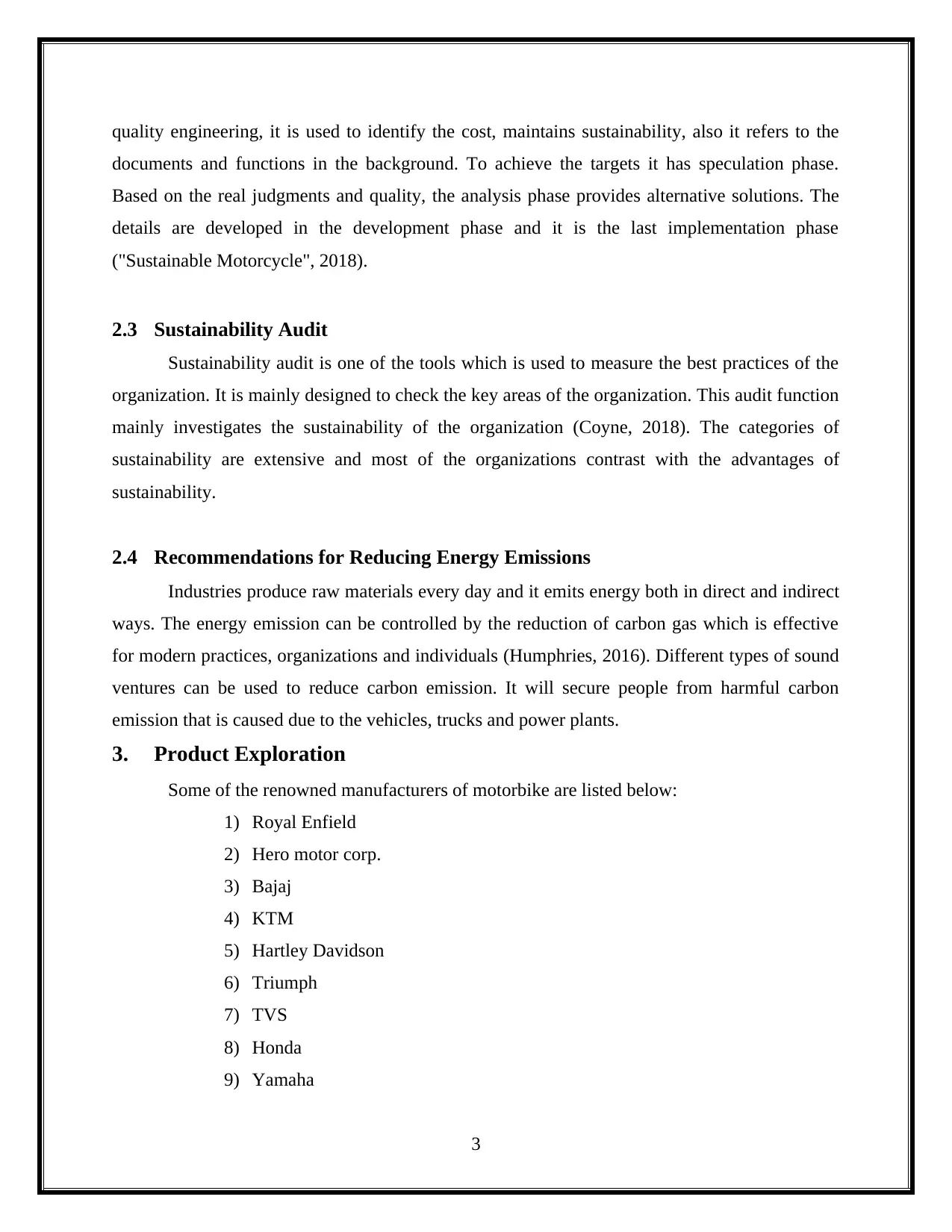
quality engineering, it is used to identify the cost, maintains sustainability, also it refers to the
documents and functions in the background. To achieve the targets it has speculation phase.
Based on the real judgments and quality, the analysis phase provides alternative solutions. The
details are developed in the development phase and it is the last implementation phase
("Sustainable Motorcycle", 2018).
2.3 Sustainability Audit
Sustainability audit is one of the tools which is used to measure the best practices of the
organization. It is mainly designed to check the key areas of the organization. This audit function
mainly investigates the sustainability of the organization (Coyne, 2018). The categories of
sustainability are extensive and most of the organizations contrast with the advantages of
sustainability.
2.4 Recommendations for Reducing Energy Emissions
Industries produce raw materials every day and it emits energy both in direct and indirect
ways. The energy emission can be controlled by the reduction of carbon gas which is effective
for modern practices, organizations and individuals (Humphries, 2016). Different types of sound
ventures can be used to reduce carbon emission. It will secure people from harmful carbon
emission that is caused due to the vehicles, trucks and power plants.
3. Product Exploration
Some of the renowned manufacturers of motorbike are listed below:
1) Royal Enfield
2) Hero motor corp.
3) Bajaj
4) KTM
5) Hartley Davidson
6) Triumph
7) TVS
8) Honda
9) Yamaha
3
documents and functions in the background. To achieve the targets it has speculation phase.
Based on the real judgments and quality, the analysis phase provides alternative solutions. The
details are developed in the development phase and it is the last implementation phase
("Sustainable Motorcycle", 2018).
2.3 Sustainability Audit
Sustainability audit is one of the tools which is used to measure the best practices of the
organization. It is mainly designed to check the key areas of the organization. This audit function
mainly investigates the sustainability of the organization (Coyne, 2018). The categories of
sustainability are extensive and most of the organizations contrast with the advantages of
sustainability.
2.4 Recommendations for Reducing Energy Emissions
Industries produce raw materials every day and it emits energy both in direct and indirect
ways. The energy emission can be controlled by the reduction of carbon gas which is effective
for modern practices, organizations and individuals (Humphries, 2016). Different types of sound
ventures can be used to reduce carbon emission. It will secure people from harmful carbon
emission that is caused due to the vehicles, trucks and power plants.
3. Product Exploration
Some of the renowned manufacturers of motorbike are listed below:
1) Royal Enfield
2) Hero motor corp.
3) Bajaj
4) KTM
5) Hartley Davidson
6) Triumph
7) TVS
8) Honda
9) Yamaha
3
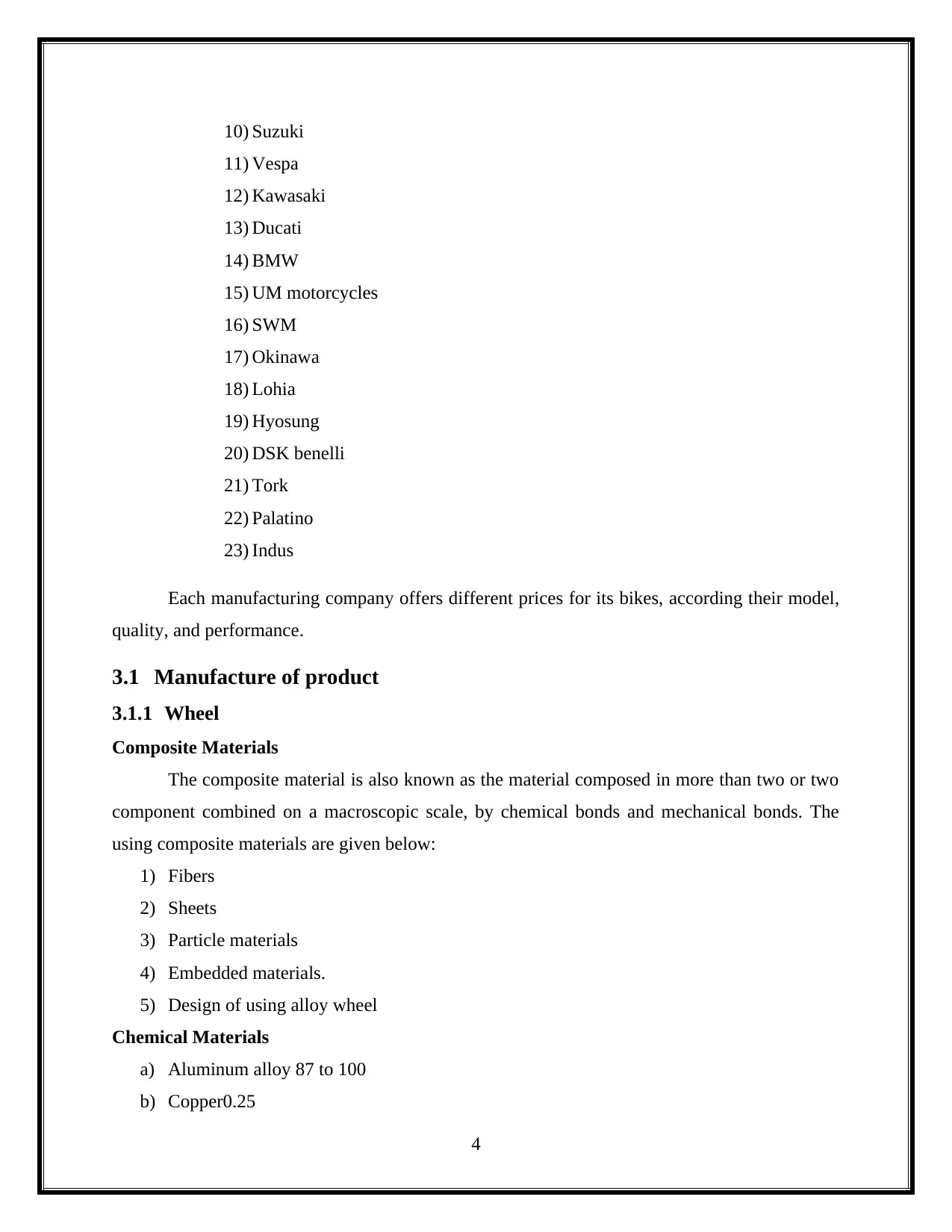
10) Suzuki
11) Vespa
12) Kawasaki
13) Ducati
14) BMW
15) UM motorcycles
16) SWM
17) Okinawa
18) Lohia
19) Hyosung
20) DSK benelli
21) Tork
22) Palatino
23) Indus
Each manufacturing company offers different prices for its bikes, according their model,
quality, and performance.
3.1 Manufacture of product
3.1.1 Wheel
Composite Materials
The composite material is also known as the material composed in more than two or two
component combined on a macroscopic scale, by chemical bonds and mechanical bonds. The
using composite materials are given below:
1) Fibers
2) Sheets
3) Particle materials
4) Embedded materials.
5) Design of using alloy wheel
Chemical Materials
a) Aluminum alloy 87 to 100
b) Copper0.25
4
11) Vespa
12) Kawasaki
13) Ducati
14) BMW
15) UM motorcycles
16) SWM
17) Okinawa
18) Lohia
19) Hyosung
20) DSK benelli
21) Tork
22) Palatino
23) Indus
Each manufacturing company offers different prices for its bikes, according their model,
quality, and performance.
3.1 Manufacture of product
3.1.1 Wheel
Composite Materials
The composite material is also known as the material composed in more than two or two
component combined on a macroscopic scale, by chemical bonds and mechanical bonds. The
using composite materials are given below:
1) Fibers
2) Sheets
3) Particle materials
4) Embedded materials.
5) Design of using alloy wheel
Chemical Materials
a) Aluminum alloy 87 to 100
b) Copper0.25
4
⊘ This is a preview!⊘
Do you want full access?
Subscribe today to unlock all pages.

Trusted by 1+ million students worldwide
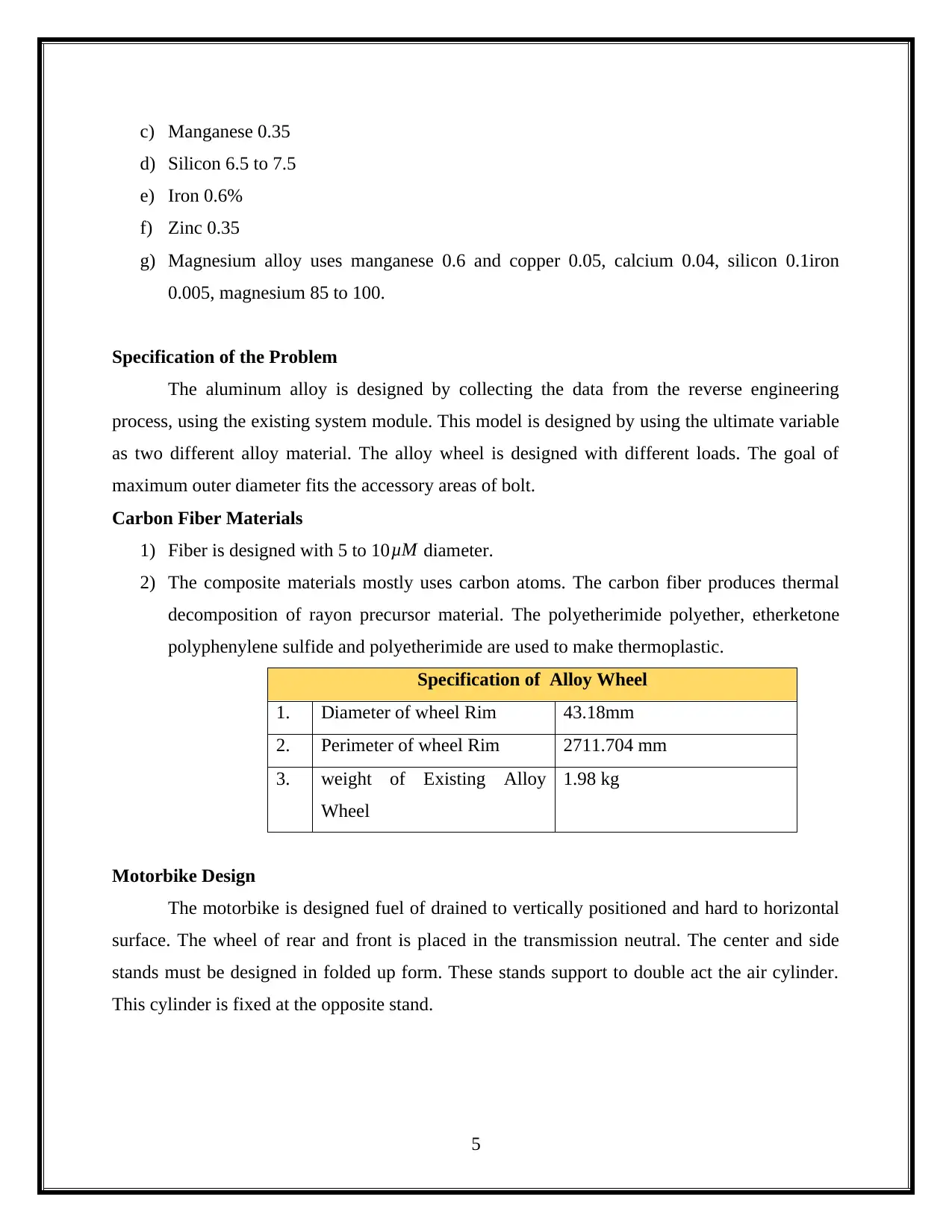
c) Manganese 0.35
d) Silicon 6.5 to 7.5
e) Iron 0.6%
f) Zinc 0.35
g) Magnesium alloy uses manganese 0.6 and copper 0.05, calcium 0.04, silicon 0.1iron
0.005, magnesium 85 to 100.
Specification of the Problem
The aluminum alloy is designed by collecting the data from the reverse engineering
process, using the existing system module. This model is designed by using the ultimate variable
as two different alloy material. The alloy wheel is designed with different loads. The goal of
maximum outer diameter fits the accessory areas of bolt.
Carbon Fiber Materials
1) Fiber is designed with 5 to 10μM diameter.
2) The composite materials mostly uses carbon atoms. The carbon fiber produces thermal
decomposition of rayon precursor material. The polyetherimide polyether, etherketone
polyphenylene sulfide and polyetherimide are used to make thermoplastic.
Specification of Alloy Wheel
1. Diameter of wheel Rim 43.18mm
2. Perimeter of wheel Rim 2711.704 mm
3. weight of Existing Alloy
Wheel
1.98 kg
Motorbike Design
The motorbike is designed fuel of drained to vertically positioned and hard to horizontal
surface. The wheel of rear and front is placed in the transmission neutral. The center and side
stands must be designed in folded up form. These stands support to double act the air cylinder.
This cylinder is fixed at the opposite stand.
5
d) Silicon 6.5 to 7.5
e) Iron 0.6%
f) Zinc 0.35
g) Magnesium alloy uses manganese 0.6 and copper 0.05, calcium 0.04, silicon 0.1iron
0.005, magnesium 85 to 100.
Specification of the Problem
The aluminum alloy is designed by collecting the data from the reverse engineering
process, using the existing system module. This model is designed by using the ultimate variable
as two different alloy material. The alloy wheel is designed with different loads. The goal of
maximum outer diameter fits the accessory areas of bolt.
Carbon Fiber Materials
1) Fiber is designed with 5 to 10μM diameter.
2) The composite materials mostly uses carbon atoms. The carbon fiber produces thermal
decomposition of rayon precursor material. The polyetherimide polyether, etherketone
polyphenylene sulfide and polyetherimide are used to make thermoplastic.
Specification of Alloy Wheel
1. Diameter of wheel Rim 43.18mm
2. Perimeter of wheel Rim 2711.704 mm
3. weight of Existing Alloy
Wheel
1.98 kg
Motorbike Design
The motorbike is designed fuel of drained to vertically positioned and hard to horizontal
surface. The wheel of rear and front is placed in the transmission neutral. The center and side
stands must be designed in folded up form. These stands support to double act the air cylinder.
This cylinder is fixed at the opposite stand.
5
Paraphrase This Document
Need a fresh take? Get an instant paraphrase of this document with our AI Paraphraser
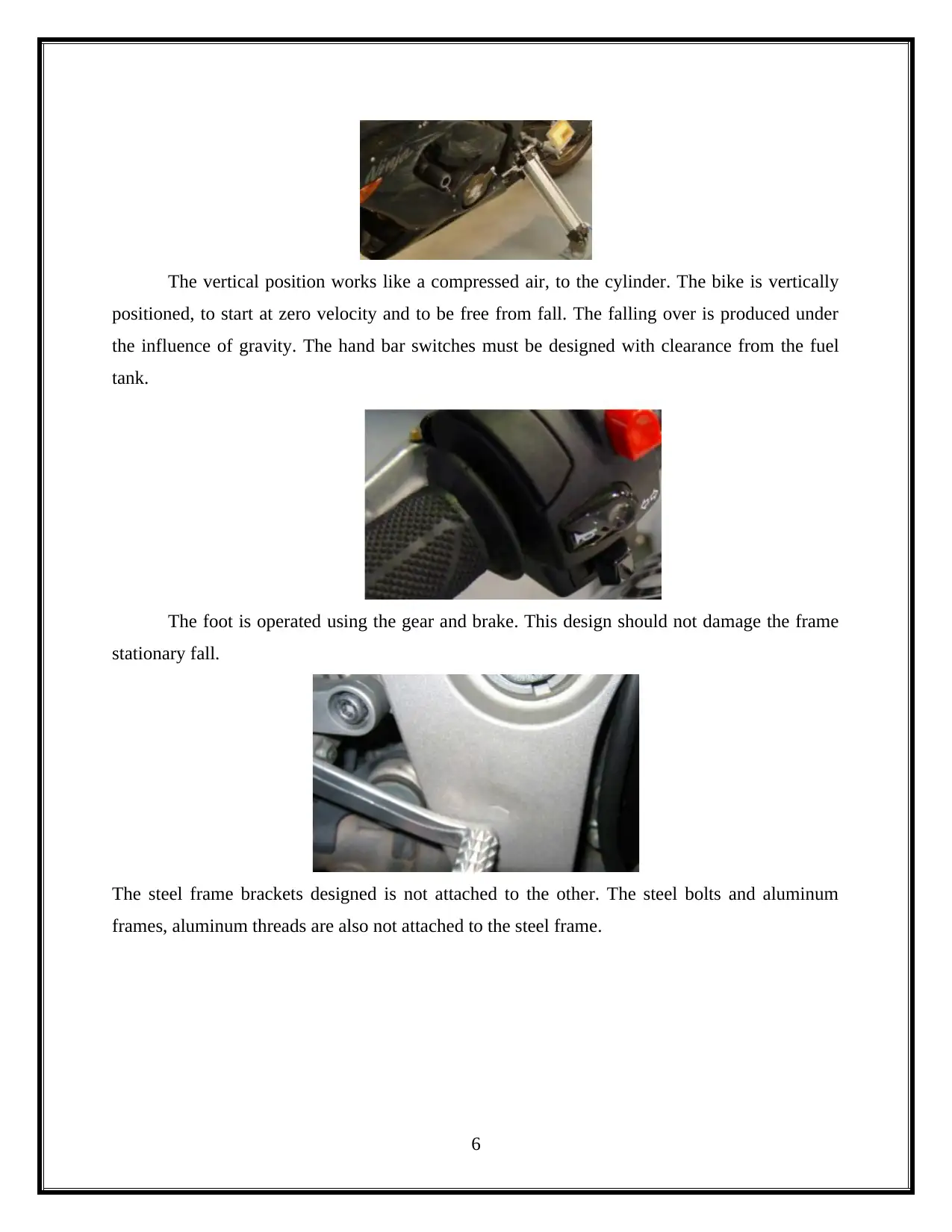
The vertical position works like a compressed air, to the cylinder. The bike is vertically
positioned, to start at zero velocity and to be free from fall. The falling over is produced under
the influence of gravity. The hand bar switches must be designed with clearance from the fuel
tank.
The foot is operated using the gear and brake. This design should not damage the frame
stationary fall.
The steel frame brackets designed is not attached to the other. The steel bolts and aluminum
frames, aluminum threads are also not attached to the steel frame.
6
positioned, to start at zero velocity and to be free from fall. The falling over is produced under
the influence of gravity. The hand bar switches must be designed with clearance from the fuel
tank.
The foot is operated using the gear and brake. This design should not damage the frame
stationary fall.
The steel frame brackets designed is not attached to the other. The steel bolts and aluminum
frames, aluminum threads are also not attached to the steel frame.
6
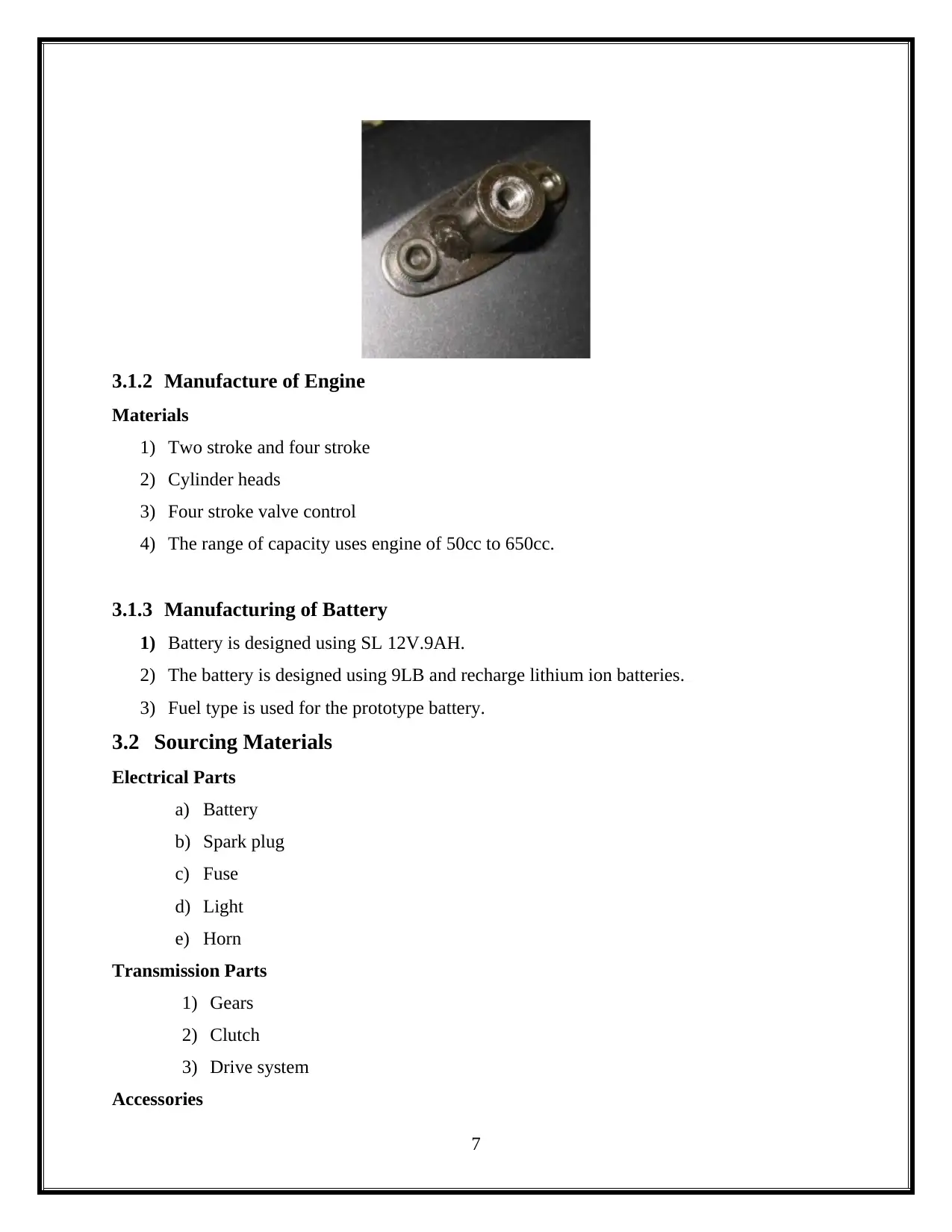
3.1.2 Manufacture of Engine
Materials
1) Two stroke and four stroke
2) Cylinder heads
3) Four stroke valve control
4) The range of capacity uses engine of 50cc to 650cc.
3.1.3 Manufacturing of Battery
1) Battery is designed using SL 12V.9AH.
2) The battery is designed using 9LB and recharge lithium ion batteries.
3) Fuel type is used for the prototype battery.
3.2 Sourcing Materials
Electrical Parts
a) Battery
b) Spark plug
c) Fuse
d) Light
e) Horn
Transmission Parts
1) Gears
2) Clutch
3) Drive system
Accessories
7
Materials
1) Two stroke and four stroke
2) Cylinder heads
3) Four stroke valve control
4) The range of capacity uses engine of 50cc to 650cc.
3.1.3 Manufacturing of Battery
1) Battery is designed using SL 12V.9AH.
2) The battery is designed using 9LB and recharge lithium ion batteries.
3) Fuel type is used for the prototype battery.
3.2 Sourcing Materials
Electrical Parts
a) Battery
b) Spark plug
c) Fuse
d) Light
e) Horn
Transmission Parts
1) Gears
2) Clutch
3) Drive system
Accessories
7
⊘ This is a preview!⊘
Do you want full access?
Subscribe today to unlock all pages.

Trusted by 1+ million students worldwide
1 out of 50
Your All-in-One AI-Powered Toolkit for Academic Success.
+13062052269
info@desklib.com
Available 24*7 on WhatsApp / Email
![[object Object]](/_next/static/media/star-bottom.7253800d.svg)
Unlock your academic potential
Copyright © 2020–2025 A2Z Services. All Rights Reserved. Developed and managed by ZUCOL.
